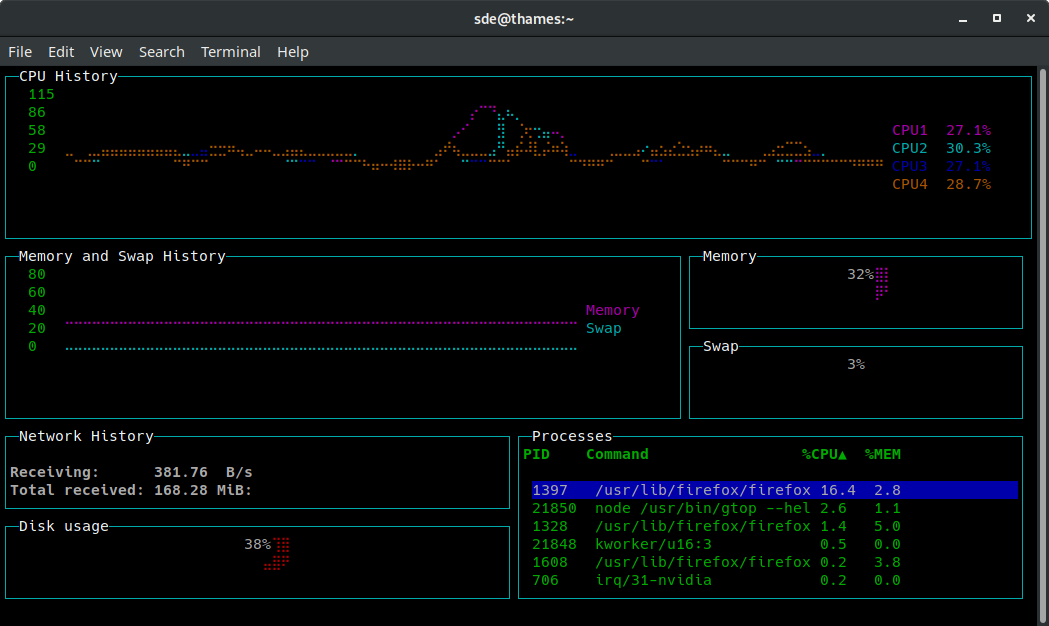Last Updated on May 28, 2022
This is the second in our series of articles highlighting essential system tools. These are small utilities, useful for system administrators as well as regular users of Linux based systems. The series examines both graphical and text based open source utilities. For details of all tools in this series, please check the table in the summary section.
We previously covered ps_mem, a really useful memory utility. This time, another console utility is under the spotlight. It’s called gtop.
gtop is an open source system monitoring utility written in JavaScript. Our Group Test covered alternatives to top. In particular, htop is a remarkable system monitoring tool. gtop receives far less exposure than htop, but deserves more publicity. Why? Let’s see.
Installation
Installing gtop is trivial; clone the project’s GitHub repository, and install the software using npm, the package manager for JavaScript.
git clone https://github.com/aksakalli/gtop.git
cd gtop
sudo npm install gtop -g
Voilà! gtop is installed.
Snaps are universal software packages. If you prefer using snaps, there’s a snap available which can be installed at a shell:
sudo snap install --edge gtop --devmode
You’ll need to append the -devmode flag as the publisher considers the snap is meant for development or testing only.
In operation
Unusually for text-based software, gtop doesn’t have any command-line options.
Here’s example output of gtop.

As you can see, there are sections illustrating CPU usage history, memory and swap history, network history, as well as a process table showing running processes detailing CPU and RAM usage for each process.
The process table can be sorted by process, CPU usage, or memory usage. In the example above, the process table is sorted by CPU usage.
What sets gtop apart from htop and top. Well, you’ll notice the useful graph history of your CPU usage, memory and swap. At a glance, you receive practical information about what’s been happening on your system, rather than a mere current snapshot. If you like dashboards, you’ll like gtop.
gtop is written in JavaScript and needs Node.js, a JavaScript runtime built on Chrome’s V8 JavaScript engine. Node.js really shines in building fast, scalable network applications, but what about small system utilities? It’s true gtop comes with a significant memory overhead. This is illustrated using the wonderful ps_mem utility.

Look at the amount of memory consumed by top and htop when compared to gtop (gtop is the node line). gtop uses over 100MB of RAM. And it guzzles cpu cycles on machines with feeble processors, such as popular single-board computers.
Summary
If your system has a frugal dollop of RAM or a feeble CPU, I’d recommend htop rather than gtop. gtop is also missing some useful functionality such as killing, filtering and searching processes, and there’s no configuration options. But the software offers a very different perspective to the state of a system, and complements htop rather splendidly.
Website: github.com/aksakalli/gtop
Support: Developer’s Other Projects
Developer: Can Güney Aksakalli
License: MIT License
gtop is written in JavaScript. Learn JavaScript with our recommended free books and free tutorials.
All the essential tools in this series:
| Essential System Tools | |
|---|---|
| Alacritty | Innovative, hardware-accelerated terminal emulator |
| BleachBit | System cleaning software. Quick and easy way to service your computer |
| bottom | Graphical process/system monitor for the terminal |
| btop++ | Monitor usage and stats for CPU, memory, disks, network and processes |
| catfish | Versatile file searching software |
| Clonezilla | Partition and disk cloning software |
| CPU-X | System profiler with both a GUI and text-based |
| Czkawka | Find duplicate files, big files, empty files, similar images, and much more |
| ddrescue | Data recovery tool, retrieving data from failing drives as safely as possible |
| dust | More intuitive version of du written in Rust |
| f3 | Detect and fix counterfeit flash storage |
| Fail2ban | Ban hosts that cause multiple authentication errors |
| fdupes | Find or delete duplicate files |
| Firejail | Restrict the running environment of untrusted applications |
| Glances | Cross-platform system monitoring tool written in Python |
| GParted | Resize, copy, and move partitions without data |
| GreenWithEnvy | NVIDIA graphics card utility |
| gtop | System monitoring dashboard |
| gWakeOnLAN | Turn machines on through Wake On LAN |
| hyperfine | Command-line benchmarking tool |
| HyFetch | System information tool written in Python |
| inxi | Command-line system information tool that's a time-saver for everyone |
| journalctl | Query and display messages from the journal |
| kmon | Manage Linux kernel modules with this text-based tool |
| Krusader | Advanced, twin-panel (commander-style) file manager |
| Nmap | Network security tool that builds a "map" of the network |
| nmon | Systems administrator, tuner, and benchmark tool |
| nnn | Portable terminal file manager that's amazingly frugal |
| pet | Simple command-line snippet manager |
| Pingnoo | Graphical representation for traceroute and ping output |
| ps_mem | Accurate reporting of software's memory consumption |
| SMC | Multi-featured system monitor written in Python |
| Timeshift | Reliable system restore tool |
| QDirStat | Qt-based directory statistics |
| QJournalctl | Graphical User Interface for systemd’s journalctl |
| TLP | Must-have tool for anyone running Linux on a notebook |
| Unison | Console and graphical file synchronization software |
| VeraCrypt | Strong disk encryption software |
| Ventoy | Create bootable USB drive for ISO, WIM, IMG, VHD(x), EFI files |
| WTF | Personal information dashboard for your terminal |

After extensive usage, I still prefer htop to gtop.